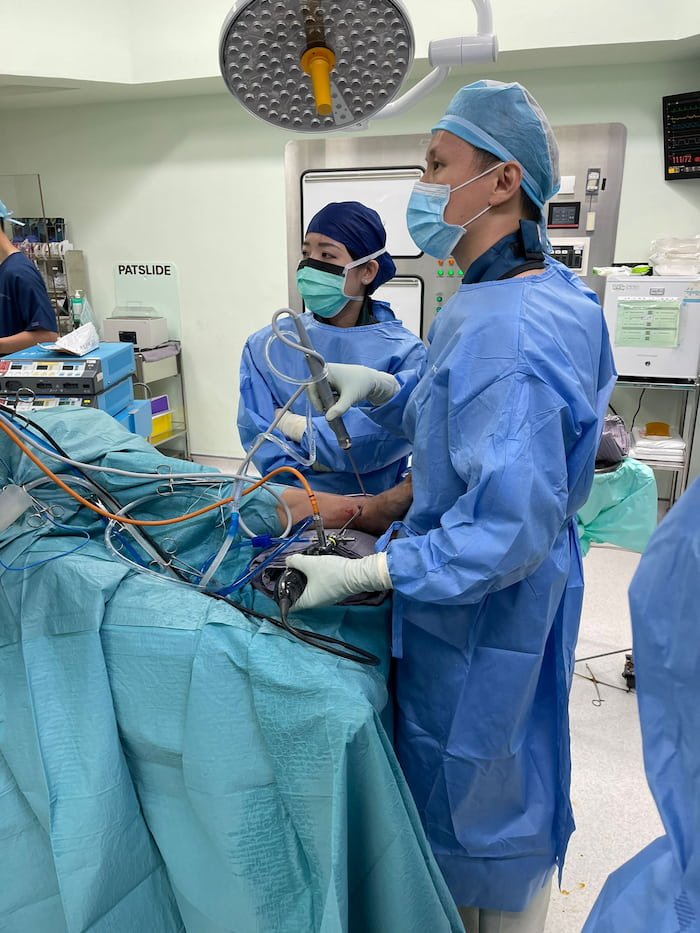
Restoring Function. Embracing Life.
Ankle Sprains Specialist in Singapore
Dr Bryan Wang
Consultant Orthopaedic Surgeon
Trusted Orthopaedic Surgeon | Fellowship-trained in Canada | With over 15-years of experience
What is Ankle Sprains?
An ankle sprain is a common injury that occurs when the ligaments that connect the bones of the ankle joint are stretched or torn due to a sudden twisting or rolling motion of the foot. Ligaments are strong, elastic bands that provide stability to the joint. Ankle sprains are categorised by their severity, ranging from mild to severe.
Ankle sprains can result from various factors, including:
Awkwardly planting the foot during sports or physical activities.
Stepping on uneven surfaces or objects.
Rolling or twisting the ankle during walking or running.
High-impact forces or trauma.
Types of Ankle Sprains
Inversion Sprain: The most common type, where the foot rolls inward, damaging the ligaments on the outer side of the ankle.
Eversion Sprain: Less common, where the foot rolls outward, injuring the ligaments on the inside of the ankle.
High-Ankle Sprain: Affects the ligaments above the ankle joint that connect the tibia and fibula, often caused by a twisting injury.
What are Ankle Sprains symptoms?
Common symptoms of an ankle sprain include:
Pain, especially when bearing weight or moving the ankle.
Swelling and tenderness around the ankle.
Bruising or discoloration of the skin.
Limited range of motion and stiffness.
Instability or feeling that the ankle is "giving way."
How to diagnose Ankle Sprains?
Clinical assessment will include taking a detailed history and a thorough examination of your shoulder.
Further imaging tests like X-rays, MRI and CT scans may occasionally be required.
Ankle Sprains Treatment
What are my Treatment options?
Treatment for an ankle sprain depends on the severity of the injury. If you have any of the symptoms above, it is advisable to see an orthopaedic specialist for further assessment.
The appropriate treatment is decided after assessment and a collaborative discussion based on your needs. They can be broadly divided into conservative (non-surgical) and surgical options.
Conservative Treatment
R.I.C.E. Method: Rest, Ice, Compression, and Elevation are the initial steps to reduce pain and swelling.
Immobilisation: Mild to moderate sprains may require a brace or splint for support.
Physical Therapy: Targeted exercises help improve ankle strength, stability, and range of motion.
Medications: Over-the-counter pain relievers and anti-inflammatory drugs can help manage discomfort.
Severe Sprains: In some cases, severe sprains may require immobilisation with a cast or walking boot.
Surgical Treatment
Surgical treatment for foot and ankle sprains is typically considered when the injury is severe and non-surgical methods have not provided adequate relief or stability.
Surgical Treatment Options:
Reconstruction of Torn Ligaments: In cases where ligaments are severely torn or detached, a surgical procedure may involve reattaching the ligaments to their anatomical positions using sutures, anchors, or other fixation devices.
Ligament Repair: Repairing a torn ligament involves suturing the ligament back together. This approach is often used for certain ligament injuries that have clean tears and are suitable for direct repair.
Ligament Reconstruction: If the ligament is extensively damaged, a reconstruction may involve using grafts (tissue from another part of the body or a donor) to replace the torn ligament. This is common in cases of chronic instability or multiple ligament injuries.
Arthroscopy: Minimally invasive arthroscopic surgery involves making small incisions and using a tiny camera (arthroscope) to visualize and repair the damaged ligaments and other structures.
Ankle Stabilisation: Some surgical techniques involve stabilising the ankle joint by using screws, plates, or other hardware to reinforce the injured area and promote proper healing.
Tendon Repair or Transfer: In cases of severe ankle instability, a tendon transfer may be performed to provide additional stability to the ankle joint.




